 #EEDay2016
#EEDay2016
On October 5, 2016, a network of groups and partners across the country will join together to promote the benefits of energy efficiency, for the first-ever, nationwide, Energy Efficiency Day campaign. This social media and press effort aims to raise awareness among the public and media by organizing participants to share related content, stories and concrete examples of the positive impact of energy efficiency.
- Highlight positive, nonpartisan messaging about energy efficiency
- Show the positive impact of energy efficiency across a range of energy users
- Share concrete, effective ways to save energy and money
Opportunities to Participate:
Government, corporate, and industrial partners can help support Energy Efficiency Day 2016 by sharing appropriate content and reaching out to the media on and before October 15, 2016. Help amplify the campaign’s energy efficiency messages via your communications channels:
- Use the campaign’s sample social media posts and memes (or your own) to direct visitors to energy efficiency tips on your own website.
- Write and post a blog about your energy efficiency success story, tips, or stories ahead of the 2016 Energy Efficiency Day.
- Issue your own press statement urging your audiences to save energy, save money.
- Promote your own energy efficiency success stories during and after the campaign.
You can download the Energy Efficiency Day toolkit here and access tons of other resources (sample content, logos, etc) online.
We encourage all VAEEC members to take part in Energy Efficiency Day through whatever appropriate means, including using #EEDay2016 in social media, pitching reporter contacts and reaching out to your customers/members/supporters via email leading up to and on October 5.
The inaugural Energy Efficiency Day is a collaborative effort of regional and national organizations working to promote energy efficiency. Participating organizations include:
- Advanced Energy Economy
- Alliance to Save Energy (VAEEC member)
- American Council for an Energy-Efficient Economy
- Appliance Standard Awareness Project
- Climate Nexus
- E4theFuture (VAEEC member)
- Keystone Energy Efficiency Alliance
- Midwest Energy Efficiency Alliance
- Northeast Energy Efficiency Partnerships
- Northwest Energy Efficiency Alliance
- NRDC
- Resource Media
- Sierra Club (VAEEC member)
- Southeast Energy Efficiency Alliance
- South-Central Partnership for Energy Efficiency as a Resource
- Southwest Energy Efficiency Project
A number of other companies and organizations have already expressed interest in participating in Energy Efficiency Day 2016. A full list of supporters (updated frequently) is available here.
This blog post was written by David Cohan, Building Energy Codes Program Manager at the U.S. Department of Energy, originally posted to the Office of Energy Efficiency and Renewable Energy website in May 2016, and republished on vaeec.org with permission.
I recently got back from Louisville, Kentucky, where I was representing DOE in the latest round of energy code development hearings. While the people who participate in the development process know energy codes inside and out, I know they are not as clear to the broader public. So let’s take a step back. Here’s a primer on what energy codes are, how they are developed, adopted, and enforced, and what DOE’s role is in these processes. Future blog posts in this series will zoom into specific topics.
First, here are a few key points:
1. CODE DEVELOPMENT
How it works: National model energy codes are developed by two private organizations, ASHRAE and the International Codes Council. ASHRAE develops the model commercial energy code, known as 90.1. The International Code Council develops the International Energy Conservation Code (IECC), which contains chapters for both residential and commercial buildings. Any interested party can participate in the development processes by submitting proposals to change the code and commenting on others’ proposals. The codes cycle is continuous, with new codes being developed every three years. Final versions of each new edition are determined by a vote of the 90.1 committee members for ASHRAE and by the International Code Council membership for the IECC.
DOE’s role: DOE participates in both the ASHRAE and ICC development processes, but has no special status. DOE develops and submit code change proposals that strive to make cost-effective, energy efficient upgrades to current model codes. After each new model code is published, DOE also must determine if the new version saves energy relative to the old version.
Note: David Cohan has another blog worth reading on this topic, “How are Building Energy Codes Developed” from August 2016.
2. CODE ADOPTION
How it works: Most codes are adopted at the state level, though, in about 10 states they are adopted by cities. State adoption can occur directly by legislative action, or through regulatory agencies authorized by the legislature. Cities adopt codes through their mayors, councils, or committees depending on their form of government. Once adopted, the code becomes law within the particular state or local jurisdiction.
DOE’s role: DOE provides technical assistance to state and local governments to support their adoption processes. DOE responds to state and local requests and it also develops customized reports for every state detailing the benefits of upgrading to the current model codes. To ensure that its information is used effectively, DOE works with the Regional Energy Efficiency Organizations (REEOs) and the National Association of State Energy Officials (NASEO) who have connections in almost every state and often participate directly in the adoption processes. DOE support also includes tracking state adoption status, coordinating activities among stakeholders, and technical analysis.
3. CODE COMPLIANCE
How it works: The key to realizing the full savings potential of building energy codes is by ensuring that builders are complying with them. Design and construction professionals are most likely to comply with the code when they are given education and training, particularly after a new code is adopted. Enforcement is almost always done by building permit office staff at the local (city) level who typically review plans first to ensure they are compliant and then conduct field inspections to verify that the plans are being followed during construction.
DOE’s role: DOE develops and regularly updates software (REScheck and COMcheck) to simplify and clarify compliance with model energy codes and standards, as well as a number of state-specific energy codes. DOE also develops education and training materials that are available free and used by governments, organizations and trainers across the country.
DOE has also developed an affordable methodology for states and cities to determine energy and dollar savings opportunities associated with increased energy code compliance in single-family homes. Field studies based on the methodology have already been implemented in nine states with more underway. The data that comes from these studies helps focus education and training programs and provides a basis for utilities and states to determine whether such programs will be cost-effective. DOE is currently developing a parallel methodology for the commercial sector.
By: Kelsey Galantich, VAEEC Intern 2016
Electricity is essential to remain connected in this day and age. There have even been acts at the international level to make electricity a human right. However, in an article recently released by The Atlantic, even in the United States affordable electricity can be hard to come by.
Most middle to upper class families spend 5% or less of their incomes on energy-related bills.[1] However, according to the article, the lower the income of the family, the higher percentage of income is spent on electricity. Data from the Department of Health and Human Services estimates that people below 50% of the poverty level consequently spend, on average, about 35% of their incomes on home energy costs in the U.S.1
For a better perspective, the map below, created by Inside Energy’s Jordan Wirfs-Brock, compares the percent of income spent on energy bills for homes below 50% of the poverty level within the continental US:
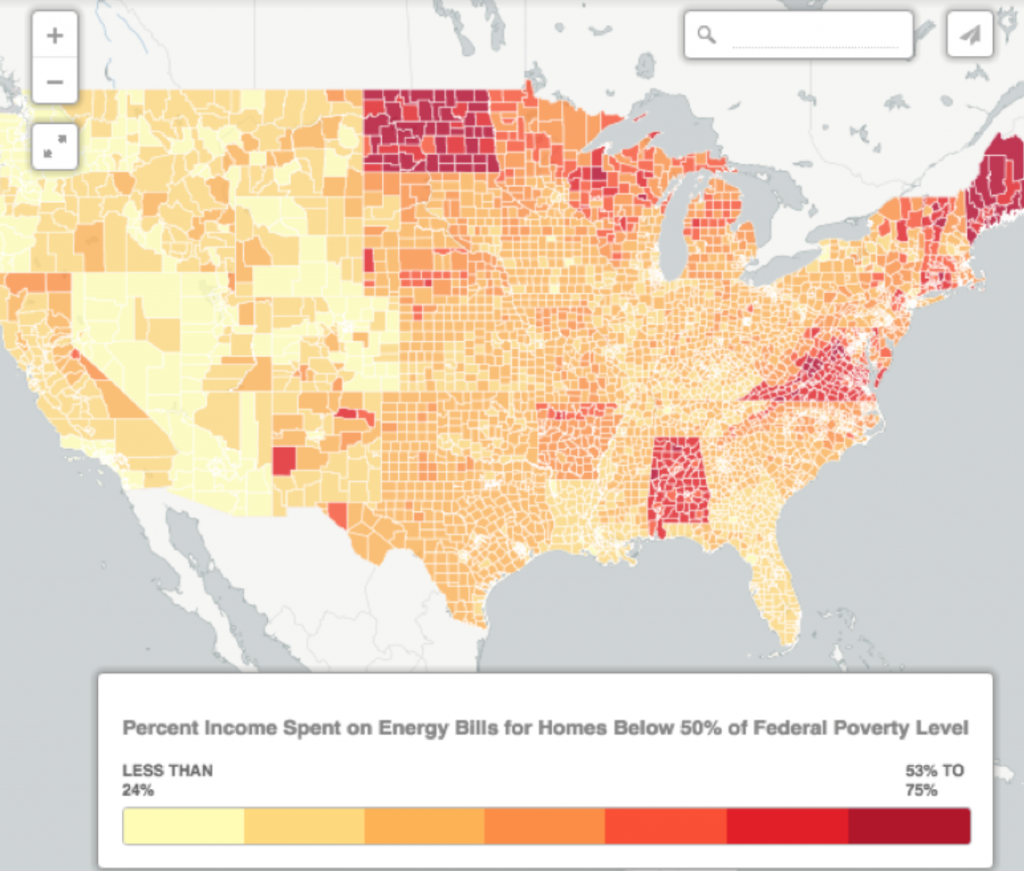
Below, is a closer look at the state of Virginia:[2]
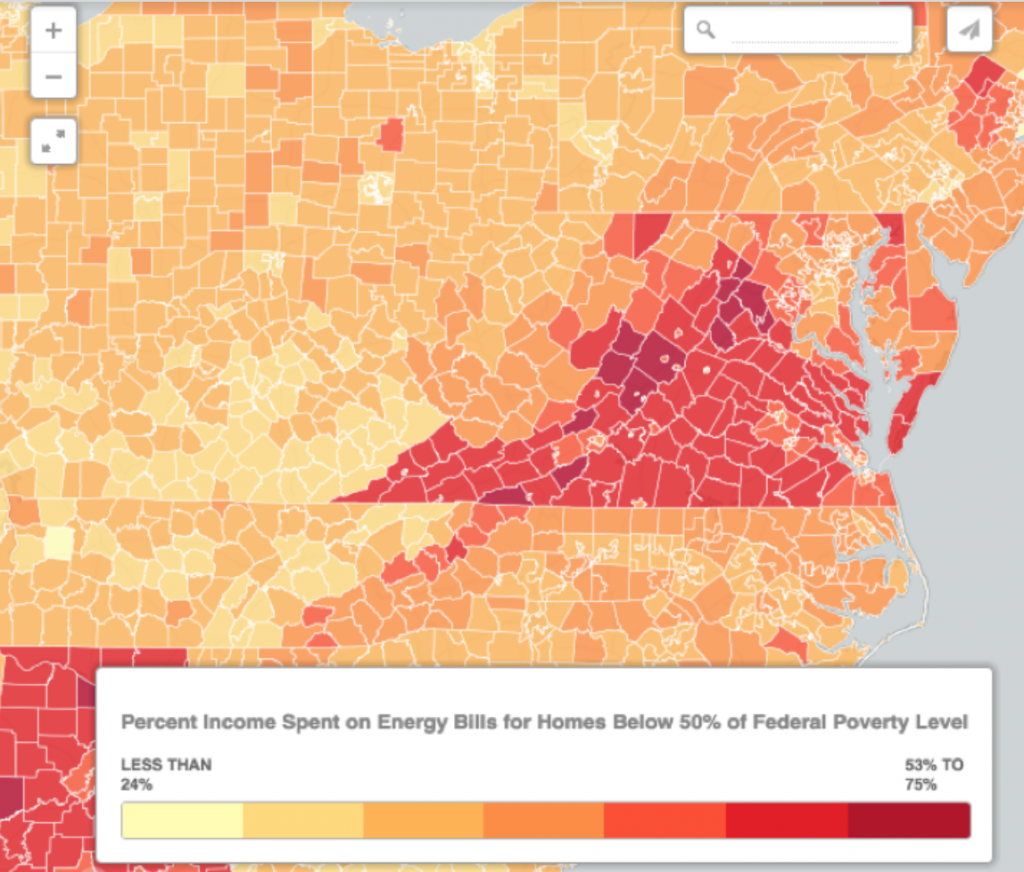
As a solution, Virginia legislators have made efforts to move forward with the federally funded Property Assessed Clean Energy (PACE) financing program. This program allows businesses to finance solar energy and energy efficiency improvements at no upfront cost, and to then pay back the cost over time with the inevitable money saved in energy bills via their property tax bill. The program is slowly moving forward in some Virginia localities, such as VAEEC Council member, Arlington County. However, though available to homeowners in other states, its expansion to private homeowners is not yet a reality in Virginia.
According to the American Council for an Energy Efficient Economy, many state utility regulators require that utilities provide bill assistance programs that complement federal programs, such as the Weatherization Assistance Program (WAP) and the Low Income Home Energy Assistance Program (LIHEAP), both of which are conducted through the U.S. Department of Energy. Some regulations also require utilities with energy efficiency programs to specifically target low-income customers [3]. For example, in Virginia, Dominion Power offers bill pay assistance and free weatherization and energy-saving upgrades through its EnergyShare program, which targets customers facing financial hardships, including military veterans and disabled individuals [4]. The program also includes one-on-one sessions with program participants, and educational outreach at community events to help people make wiser energy decisions. Similarly, another VAEEC member, the Local Energy Alliance Program (LEAP) offers free in-home energy assessments by expert building 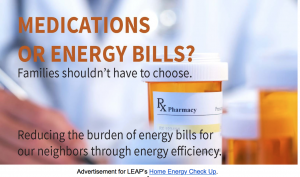 analysts for Dominion customers, which are available to households with an income threshold of 60% of the state median income, households with elderly and disabled citizens and Veterans, and Dominion EnergyShare customers. These analysts provide a custom report recommending energy saving products, free installment of selected improvements, and post-installment visits to ensure improvements’ success [5]. Community Housing Partners yet another VAEEC member, located in Christiansburg, VA offers weatherization services through WAP, which involve a site-specific energy audit of the home, along with repairs and improvements, such as the installation of energy-saving measures. This service targets low-income families, in particular those with elderly residents, disabled individuals, and children [6].
analysts for Dominion customers, which are available to households with an income threshold of 60% of the state median income, households with elderly and disabled citizens and Veterans, and Dominion EnergyShare customers. These analysts provide a custom report recommending energy saving products, free installment of selected improvements, and post-installment visits to ensure improvements’ success [5]. Community Housing Partners yet another VAEEC member, located in Christiansburg, VA offers weatherization services through WAP, which involve a site-specific energy audit of the home, along with repairs and improvements, such as the installation of energy-saving measures. This service targets low-income families, in particular those with elderly residents, disabled individuals, and children [6].
Increased energy efficiency is essential to making electricity more affordable and accessible. These national and local initiatives have the potential to help millions of low-income Americans keep the lights on while also staying fed, offering hope for a more efficient, cleaner, and sustainable communities at reduced cost, no matter the income.
Does your utility, nonprofit or company offer programs or opportunities for families in need in Virginia to reduce the burden of their energy bills? Let us know by emailing info@vaeec.org and we’ll update this post!
[1] http://www.theatlantic.com/business/archive/2016/06/energy-poverty-low-income-households/486197/
[2] These maps are based on original analysis by independent firm, Accounting Insights, who shared their data with Inside Energy. The annual energy bills were determined by information regarding energy use, type, and price from the Energy Information Administration, and information on household size, tenure, type of fuel used from the U.S. Census Bureau. This information was compiled into a model that estimated the annual energy cost for each U.S. county. Inside Energy then divided the average annual energy bill by the income midpoint for households living under 50% of the federal poverty level to come up with the percent of income owed to energy bills.
[3] http://aceee.org/sites/default/files/publications/researchreports/u1602.pdf
[4] https://www.dom.com/residential/dominion-virginia-power/in-the-community/energyshare
[5] http://leap-va.org/saveaton/
[6] https://www.communityhousingpartners.org/312/weatherize.html
On September 7 we hosted a conference call to answer questions about our upcoming VAEEC Energy Efficiency Leadership. Below you’ll find a rough transcript of that Q&A. Please direct additional questions about the awards to info@vaeec.org.
- What should we expect at VAEEC’s First Annual Awards Ceremony?
We first wanted to see what type of applicants we would get- we received 2 dozen. We have two application categories: One for business and one for projects.
The type of sector your organization works in will help determine the award categories. The decision will be made by the Selection Committee. The selection committee is made up of 6 people- 3 members and 3 board members.
The application process closes Friday October 14th. The Selection Committee will convene and will have a chance to review all applications to discuss criteria and our nominees in each category. We really want to showcase as many companies as possible and show how much work is going on in Virginia. It’s important that we highlight as many companies as possible.
- The nomination application process seems simple and wants applicants to list out goals and outcomes of their project. Is that all you want to know?
Yes, we researched what other awards applications looked for and they are very similar.
- Do the nominees and specific projects have to be in Virginia?
The company does not have to be headquartered in Virginia, but they should have an office in Virginia. For projects, yes, it has to be in Virginia. The project already be completed.
- Is there a minimum requirement for how long a project has been completed?
No requirements.
- When is the Application Deadline?
Friday October 14th
- What does the Selection Committee process look like?
The staff will package applications for the Selection Committee to review once the application process closes on October 14th. The Selection Committee will convene 2 meetings: one in late October and one in early November.
Grading sheets will be used so that each project and company will be graded based upon the same merits. The Selection Committee will then come back for a second meeting during the first week of November to discuss grades and choose winners. The staff will then reach out to award winners to make sure someone from the company can attend the Awards Ceremony.
- When will you notify the winner?
We will notify winners the second or third week of November- definitely before Thanksgiving.
- When and where is the Awards Ceremony?
The Awards Ceremony will take place at the University of Richmond on November 29, 2016 from 4:30pm-6pm, immediately following the VAEEC biannual member meeting.
Schedule:
1:00-400pm Member Meeting
4:30-6:00pm Awards Ceremony
We want this to be a more laid back and networking atmosphere where energy efficiency industry representatives can celebrate our collective efforts in the energy efficiency field.
We are also looking for sponsors for the full day. We plan to announce our sponsor packages sometime next week. Award winners and nominees will be able to sponsor the event if they so choose.
- Is there a ticket cost to get into the ceremony?
We’re doing something new this Fall and will be charging non-members for the member meeting. The Awards Ceremony will be free of charge. Overall the purpose of the meeting will be to raise awareness for the Council and to celebrate energy efficiency efforts in Virginia. We are excited to showcase the work you all have done in the state.
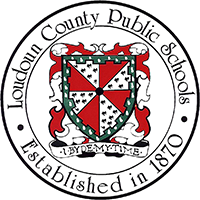 Thanks to Loudoun County Public Schools (LCPS) Energy & Environment Team Administrators John Lord and Michael Barancewicz for submitting their energy efficiency success story. September 2016.
Thanks to Loudoun County Public Schools (LCPS) Energy & Environment Team Administrators John Lord and Michael Barancewicz for submitting their energy efficiency success story. September 2016.
Their success:
LCPS is the third largest school division in the Commonwealth of Virginia. LCPS serves more than 78,000 students in 89 facilities. Since 1993, LCPS has implemented an energy management program in partnership with Cenergistic. This partnership revolutionized how our district views, consumes and uses energy. The LCPS behavioral-focused energy conservation and efficiency program – THE LCPS ENERGY & ENVIRONMENT TEAM — is focused on changing behaviors to realize significant savings. Since 1993, LCPS has saved over $70 Million on energy costs, reduced CO2 emissions by over 352,000 metric tons, and kept dollars that may have otherwise been spent to pay unnecessarily high energy bills available to be spent for a much better purpose – teaching children. Due in part to the efforts of this team, LCPS won First Place in the Virginia School Boards Association’s 2011 Green Schools Challenge and has earned the EPA ENERGY STAR Partner of the Year Award for 2010 & 2011 as well as 2012, 2013, 2014, 2015 & 2016 EPA ENERGY STAR Partner of the Year – Sustained Excellence Awards.
Tell us more about your story:
 The LCPS Energy & Environment Team uses both energy efficiency and energy conservation to accomplish the goal of ensuring efficient and effective stewardship of public resources through continually striving to reduce district energy use and cost without negatively impacting health and safety, the educational environment or productivity.
The LCPS Energy & Environment Team uses both energy efficiency and energy conservation to accomplish the goal of ensuring efficient and effective stewardship of public resources through continually striving to reduce district energy use and cost without negatively impacting health and safety, the educational environment or productivity.
Energy Conservation is the ability to capitalize on behavioral practices which allow LCPS to simply use less energy with existing resources. The tools used include: ingenuity, resourcefulness, discipline, procedures, volunteerism, and all the things that make people great.
Energy Efficiency is the ability to capitalize on new technologies and equipment that will accomplish desired outcomes while using less energy. Giving people more efficient tools allows those who are already conserving to use less energy when energy needs to be expended.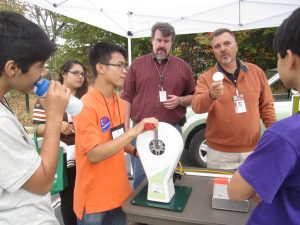
By using both conservation and efficiency methods, the greatest possible success is achieved. However, our real strength is the team itself. At over 90,000 individuals, the LCPS Energy & Environment Team includes all students, staff, parents and other community members who make up the totality of individuals who utilize LCPS sites. By having everyone take part, an empowering alliance in the school system has been created that keeps energy costs within our control.
Find out more about the LCPS Energy & Environment Team.
What was the problem or opportunity you identified?
LCPS had a need for additional funds to use in the classroom and those funds were not forthcoming through “traditional” means. The LCPS Energy & Environment Team has been a consistent success in focusing the expenditure of taxpayer dollars on instruction.
How has this impacted your clients/constituents/
members?
LCPS has saved enough money on energy to buy a new middl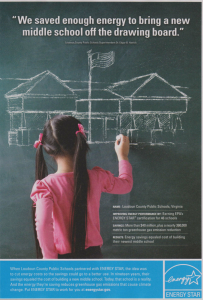 e school.
e school.
The ENERGY STAR program thought the LCPS success story was worthy of nationwide promotion and ran the ad at right in Fortune Magazine in 2013. Ultimately, students benefit and that is what LCPS does – through our example, we are teaching the value of both economic and environmental stewardship.
What challenges did you face along the way?
LCPS has been doing this work for over 20 years; the challenges have been many and complex. Growth of the district has been intense as LCPS has tripled in size over this time. Changes in leadership and the cost per unit of energy can provide both opportunities and challenges. As Jim Collins said: “Good is the enemy of great. And that is one of the key reasons why we have so little that becomes great.” Simply focusing on not allowing ourselves to be good enough has probably been the greatest hurdle. Continuing to grow, evolve, innovate and adapt through changing times is never easy.
In what ways could this have implications for Virginia’s energy efficiency landscape?
If every school district could save over 28% on its energy costs, as LCPS has been able to do for the last 20 years, the effect would be astounding. Choosing to take the LCPS approach has positive implications for people, the planet, and proficiency of students.
What’s the next step for you?
The LCPS Energy & Environment Team has begun using social media to help educate folks and get the message out, feel free to follow us on Twitter @LCPSeeteam. LCPS continues to focus on certifying more of our building as ENERGY STAR schools. We have moved from seven certified in 2008 to fifty-five certified in 2015. We expect to have even more in 2016. Constant vigilance and laser focus on the small details will be how we move forward.
What “lessons learned” would you share with other VAEEC members?
Imagine an old man out in the country rocking in his chair on his front porch. Beside him, his faithful dog snoozing on the porch next to him. Each day the neighbor would walk by, and most days it is peaceful and calm, but from time to time the dog’s tail slips under the rocker. The dog lets out a horrible wail and clearly is in pain, but shortly he settles back into dreamland next to the old man. One day the neighbor asks him: “Why doesn’t your dog just move?” The old man responds: “Don’t hurt enough yet.” Our advice is don’t wait until it hurts too much not to move; move as soon as you can. Failure to act or delay in taking action has a cost that can never be recovered. There is no time but now!
Want to learn even more about LCPS success? Contact:
John Lord & Michael Barancewicz
Energy Education Specialists
Loudoun County Public Schools
1002-C Sycolin Road, SE | Leesburg, VA 20175
(571) 252-2960
eeteam@lcps.org
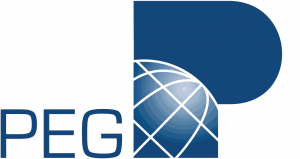 Established in 1998, PEG is a Woman-owned multi-disciplinary engineering, environmental and energy consulting firm that is experienced in working with Residential Construction, Local and Federal Government Agencies, Non-Profit Industries, Private Corporations and Individuals.
Established in 1998, PEG is a Woman-owned multi-disciplinary engineering, environmental and energy consulting firm that is experienced in working with Residential Construction, Local and Federal Government Agencies, Non-Profit Industries, Private Corporations and Individuals.
Headquartered in Fairfax, VA, PEG has a proven track record of success through an understanding and long standing commitment to environmental quality; the natural environment, the built environment, building standards, codes and best practices, building performance standards and understanding of human interaction with their surroundings as it relates to their use of material, energy, and water resources.
The PEG Headquarters staff consists of engineering, energy efficiency, and management professionals that manage hundreds of technical field representatives in more than 28 States. PEG has staff accredited by the USGBC, NEBB, ICC, RESNET, NAHB, AIHA, AEE and BPI. PEG is both a National Provider and Authorized Education Delivery Partner for RESNET and the USGBC.
One specific area of expertise at PEG’s disposal is residential energy efficiency and above code design & development. PEG manages multi-state residential energy efficient and green building construction programs for many production home builders, custom home builders, non-profit housing organizations, utility companies and utility providers. As the housing market endeavors to adapt to the current economic climate, there are challenges to overcome relative to changing codes, cost of construction, competition with other new home builders as well as with existing housing stock.
PEG released a white paper in June 2016 about the Department of Housing and Urban Development’s (HUD) 2016 Multifamily Accelerated Processing Guidelines and the the Federal Register Notice detailing significantly reduced premium rates on mortgage insurance, termed “MIP Reductions.” PEG found that “HUD has created a far reaching incentive to adopt green standards and energy efficiency in the residential construction industry. Not relegated to affordable housing, multifamily projects committed to energy efficiency have the opportunity to reduce their Mortgage Insurance Premiums to a locked .25% over the life of the mortgage.”
Read their white paper here.
The Virginia Energy Efficiency Council is seeking proposals from subject matter experts in the Property Assessed Clean Energy (PACE) field to help us provide technical and legal services to local governments in Virginia who are considering the creation of PACE financing programs.
Download the RFP.
Important Dates:
8/25: Registration deadline; deadline to ask up to 5 questions
9/1: All submitted questions, with answers, will be sent to all registered applicants
9/8: Proposals Due
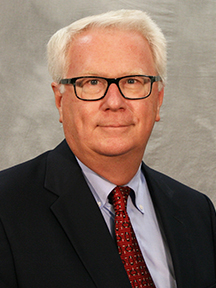 Guest Post by Andy Farmer, Education Resources Manager, Virginia State Corporation Commission
Guest Post by Andy Farmer, Education Resources Manager, Virginia State Corporation Commission
 Virginia Energy Sense (VES), a program of the State Corporation Commission of Virginia, is tasked with helping the state achieve its goal of reducing electric energy consumption 10 percent below 2006 levels by 2020.
Virginia Energy Sense (VES), a program of the State Corporation Commission of Virginia, is tasked with helping the state achieve its goal of reducing electric energy consumption 10 percent below 2006 levels by 2020.
At VES we believe everyone can help reach that goal if given the right information. As such, we reach out to, engage, and educate Virginians about simple and easy ways to reduce electric energy use. Once people engage us, they soon realize that energy efficiency and energy conservation are the most affordable ways to help our state achieve this goal.
Reducing electric energy use puts money back in consumers’ pockets and helps Virginia’s economy and environment. That’s why saving energy just makes sense. And it’s why we are working hard to inform our fellow Virginians.
Strengthening Our Foundation
In early 2015 VES devised a new strategic outreach plan to engage more Virginians to help the state meet its goal. This plan consisted of three primary phases:
- Redefining our key audiences
- Refining our messages
- Determining the best ways to reach our key audiences
To ensure we reached the right people with the right messages, VES commissioned a research survey. Through this survey we discovered the right people consisted of citizens likely to take steps in the near future to make their home more energy efficient. Generally speaking, these people own their home, which are typically newer. We named this group of citizens “motivated savers.”
Utilizing the demographics gathered from the survey, we identified the best ways to reach motivated savers. These approaches included participation in community events, traditional media, digital media, television and digital advertising, and a fully revamped website.
Executing the Plan
Taking all of our findings, we developed a comprehensive outreach plan that focused on each of the approaches we identified to reach large numbers of motivated savers.
Partnerships and Community Events
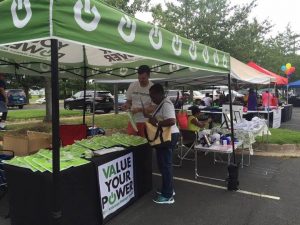
An attendee at the 26th Annual Manassas African American Heritage Festival on Aug. 6 learns more about easy ways to save energy
While we already had a nice array of partnerships with organizations across the state, we added more than 40 partners, increasing our total partners to nearly 100. Through these partnerships, we estimate we can reach more than one million Virginians, many of whom are motivated savers.
In addition, through VES’s participation in more than two dozen community events during the first phase of the new outreach plan we engaged an estimated 150,000 Virginians in person. Participation in large community-based events allows VES the opportunity to engage large numbers of citizens in a highly personal and engaging way, ensuring a positive impact.
Media
Overall, our earned media efforts resulted in more than 750,000 impressions through a variety of media hits in 2015 and 2016. These hits included coverage in newspapers, op-ed placements, and multiple on air television and radio interviews in key markets such as Roanoke, Harrisonburg, and Richmond.
Advertising
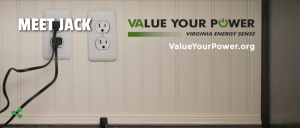 Our advertising approach consisted of traditional on-air television advertising as well as a creative digital, social media driven campaign
Our advertising approach consisted of traditional on-air television advertising as well as a creative digital, social media driven campaign
which featured a new VES spokesperson, Jack, a wise-cracking, talking power plug.
 The traditional television advertising was a Public Service Announcement (PSA) that focused on the idea of “spending your energy elsewhere.” This advertisement was placed across the state and targeted to programming and stations that aligned with our “motivated savers” audience demographic. We estimated that the PSA delivered more than 5 million impressions giving us a reach of up to 96 percent in many key markets, including Harrisonburg, Roanoke, Hampton Roads, Richmond, and Fredericksburg.
The traditional television advertising was a Public Service Announcement (PSA) that focused on the idea of “spending your energy elsewhere.” This advertisement was placed across the state and targeted to programming and stations that aligned with our “motivated savers” audience demographic. We estimated that the PSA delivered more than 5 million impressions giving us a reach of up to 96 percent in many key markets, including Harrisonburg, Roanoke, Hampton Roads, Richmond, and Fredericksburg.
Shortly after the PSA aired in November 2015, we launched the digital campaign featuring Jack. All told, four Jack digital videos resulted in more than 300,000 views, with a watch rate of 47 seconds (out of about 60 seconds for each one), meaning people watch almost the entire video.
Website
With the other elements of our outreach plan completed and in place, we focused on revamping the VES website, which served as the focal point of many of our outreach efforts. The website houses all of the tips, tools, materials and related resources we direct Virginians to through our outreach efforts.
The website, while very comprehensive in terms of content had become outdated from a functionality perspective and didn’t align with the evolving VES brand.
To upgrade the website, we focused on some key changes to bring the website current with best practices, making the site more functional. These changes included integrating modified drop down menus that help drive a more engaging experience and leveraging Jack by having his “at home” video running in the background.
In addition, from a layout perspective, we ensured that as users scrolled
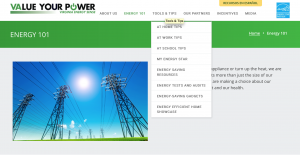 down the main page that tools and tips, resources for use in schools, and information on partnering with VES were kept front and center, as those are items that have been utilized extensively by site visitors.
down the main page that tools and tips, resources for use in schools, and information on partnering with VES were kept front and center, as those are items that have been utilized extensively by site visitors.
We also ensured the 10% challenge sign up form is highlighted on nearly every page on the site, making it easy for folks to take the challenge and join the VES effort.
Finally all of the site’s existing content was reviewed and updated where appropriate to ensure the best experience possible for those who visit the site.
The Impact
The work over the past 18 months has resulted in large numbers of Virginians learning more about how saving energy can save them money and help the state reach its stated goal of reducing electric energy consumption 10 percent below 2006 levels by 2020.
We have seen a large number of citizens sign up and take the 10 percent pledge, further validating our work. Our presence on social media platforms has grown the number of citizens we can contact directly, many of whom are motivated savers we can call to action.
We are encouraged by the progress we’ve made the last few years, and look forward to seeing an even more meaningful impact on Virginia’s electricity consumption over the coming years. To that end, we hope that VAEEC members and those interested in advancing Virginia’s energy goals and the energy efficiency industry will share the VES website and resources with clients, constituents and colleagues.
Southland Energy (Business Silver) has a new video out that spotlights 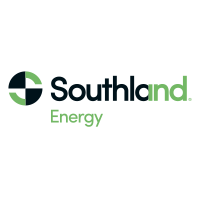 the company’s work with the private St. Anne’s Belfield School in Charlottesville. The company installed comprehensive energy and water saving upgrades for the school, including seven buildings across two campuses.
the company’s work with the private St. Anne’s Belfield School in Charlottesville. The company installed comprehensive energy and water saving upgrades for the school, including seven buildings across two campuses.
Southland Energy’s scope of work involved lighting upgrades, boiler, chiller, and fan coil unit replacements, controls upgrades and integration, high efficiency pumps, motors, and variable frequency drives. In addition, Southland Energy performed water saving upgrades, comprised of plumbing fixtures and irrigation.
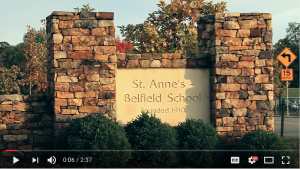 Together the project reduced the school’s carbon footprint by 28 percent, will save more than 1 million gallons of water a year, and save $4.5 million over the project life.
Together the project reduced the school’s carbon footprint by 28 percent, will save more than 1 million gallons of water a year, and save $4.5 million over the project life.
Watch the short video.
You can also learn more about this success story here.
Columbia Gas of Virginia (Business Silver member) has launched a new phase of WarmWise, the company’s energy efficiency and conservation program aimed at reducing customers’ energy usage. With this new phase comes enhanced programs for both residential and business customers. WarmWise is also continuing to partner with contractors across Virginia to educate customers on these rebate programs.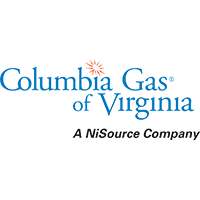
In addition to continuing residential rebates offered for floor insulation, attic insulation, energy efficient windows and gas furnaces, the WarmWise Home Savings Program now offers rebates for smart thermostats and energy efficient doors and skylights. Through the Business Savings Program, commercial customers may receive rebates for smart thermostats, high-efficiency gas furnaces and attic insulation in addition to previously offered rebates for boiler controls, infrared heaters and free high-efficiency pre-rinse spray valves.
 Also new to the program, residential customers may qualify for up to two free Energy Efficiency Kits when they complete the WarmWise Home Savings Evaluation – a free online home energy audit. Customers with natural gas space heating can now receive a free Energy Efficiency Kit with door sweeps and weather stripping. The Energy Efficiency Kit containing faucet aerators and high-efficiency shower heads is again available to customers with natural gas water heating. All customers who complete the evaluation will also receive energy savings tips customized to their homes.
Also new to the program, residential customers may qualify for up to two free Energy Efficiency Kits when they complete the WarmWise Home Savings Evaluation – a free online home energy audit. Customers with natural gas space heating can now receive a free Energy Efficiency Kit with door sweeps and weather stripping. The Energy Efficiency Kit containing faucet aerators and high-efficiency shower heads is again available to customers with natural gas water heating. All customers who complete the evaluation will also receive energy savings tips customized to their homes.
To learn more about energy-saving opportunities, visit WarmWiseVA.com.
 #EEDay2016
#EEDay2016



 analysts for Dominion customers, which are available to households with an income threshold of 60% of the state median income, households with elderly and disabled citizens and Veterans, and Dominion EnergyShare customers. These analysts provide a custom report recommending energy saving products, free installment of selected improvements, and post-installment visits to ensure improvements’ success [5].
analysts for Dominion customers, which are available to households with an income threshold of 60% of the state median income, households with elderly and disabled citizens and Veterans, and Dominion EnergyShare customers. These analysts provide a custom report recommending energy saving products, free installment of selected improvements, and post-installment visits to ensure improvements’ success [5]. 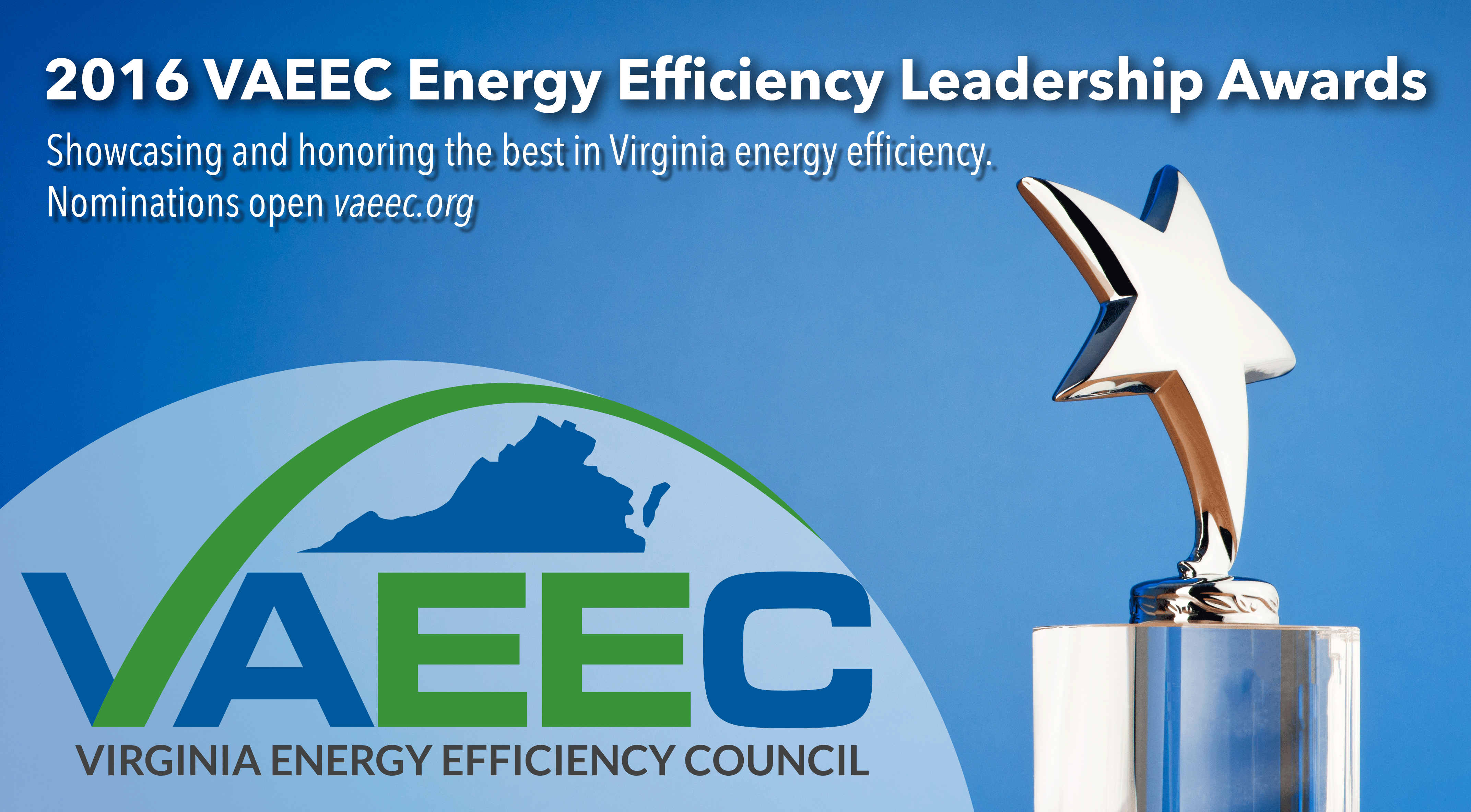

 Thanks to
Thanks to  The
The 
 e school.
e school.
 Established in 1998,
Established in 1998, 
 Guest Post by Andy Farmer, Education Resources Manager, Virginia State Corporation Commission
Guest Post by Andy Farmer, Education Resources Manager, Virginia State Corporation Commission




 the company’s work with the private St. Anne’s Belfield School in Charlottesville. The company installed comprehensive energy and water saving upgrades for the school, including seven buildings across two campuses.
the company’s work with the private St. Anne’s Belfield School in Charlottesville. The company installed comprehensive energy and water saving upgrades for the school, including seven buildings across two campuses.

